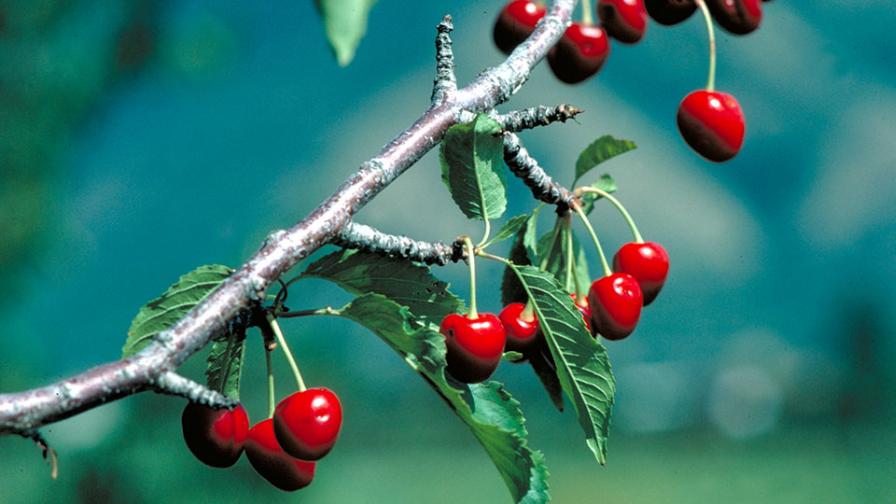A Solution To Fending off Leafhoppers in Stone Fruit

Leafhoppers, which are vectors of the X-disease phytoplasma in sweet cherries, can be controlled with several insecticides, according to a Washington State University study. Photo by F. Dosba, INRA, Bordeaux, Bugwood.org
Five conventional insecticides and one organic alternative are highly toxic to leafhoppers upon direct spray contact, according to a continuing 2020-21 trial conducted at Washington State University (WSU).
Researchers Louis Nottingham and Katlyn Catron presented their results at the Northwest Cherry and Stone Fruit Research Review, hosted by the Washington Tree Fruit Research Commission (WTFRC) and Oregon Sweet Cherry Commission (OSCC).
The news could bode well for sweet cherry growers in the Pacific Northwest, where X-disease and little cherry disease are at epidemic levels. The X-disease phytoplasma is vectored by several leafhopper species, including Colladonus reductus, C. montanus, and Fieberiella florii.
“Prior to this project there were no current insecticide efficacy data,” Nottingham, a Research Assistant Professor at WSU, says. “So, we kind of had to start from scratch and then screen as many organic and conventional products as possible, guided by growers and crop consultants.”
The goal, Nottingham says, was to determine which products are consistently effective in the lab. “That way we could kind of eliminate ones that weren’t and continue to test those that were in more detailed testing,” he says.
In addition to conducting four direct spray bioassays on each insecticide, two residue control bioassays were performed to determine how long the products would last following direct spray.
“We couldn’t perform in-field trials because of the high risk of X-disease spread into controlled plots or plots used to test ineffective materials,” Nottingham says.
REPEAT SUCCESS
Among the five insecticides that were evaluated in both the 2020 and 2021 trials, two conventional products boasted 100% mortality of C. reductus upon direct spray: Actara (thiamethoxam, Syngenta) and Asana (esfenvalerate, Valent).
Actara sets itself apart with an 85% mortality rate at short-term residue (24 hours or less) and 70% mortality rate at long-term residue (longer than 24 hours). Asana’s numbers at the same exposures were 80% and 40%, respectively.
“Actara has really high — about 100% — immediate mortality, and we’ve seen that that mortality continues to be high all the way up to a week after treatment. That seems to be the top material,” Nottingham says. “Asana also has high mortality; however, the efficacy seems to decrease pretty rapidly. In one of the tests, it kind of hung on a little bit longer than the other, but in the first test it really dropped off quite rapidly. So, I have much less confidence that Asana is going to continue to provide as effective control as the Actara.”
ORGANIC ALTERNATIVE
On the organic side, the pyrethrin Pyganic (Valent) posted a leafhopper mortality rate of 98% in the 2020-21 trials combined. That rate fell to 35% and 10% at short- and long-term residue, respectively.
“As far as organics, the only product that really seems to be effective is anything with pyrethrin,” Nottingham says.
While Pyganic is the “main one” among pyrethrins, according to Nottingham, Azera (Valent), which is a premix of pyrethrin and azadirachtin, posted a 100% mortality rate upon direct spray, although its evaluation occurred in only one of the two trials, with residue testing not performed as well.
“We didn’t see from our tests that azadirachtin is effective; however, the pyrethrin within that premix seemed to work well,” Nottingham says. “There’s potential that there are some slower suppressive effects from the azadirachtin, but Pyganic organics are going to be your top material.”
SINGLE-TRIAL SUCCESS
Another three conventional insecticides — Admire Pro (imidacloprid, Bayer Crop Science), Scorpion (dinotefuran, Gowan), and malathion — posted 100% mortality rates upon direct spray while being evaluated thus far in only one of the two trials.
“Those need to be performed more times for greater confidence,” Nottingham says. “At least two trials are necessary to include the information in the (WSU) crop protection guide, which is our primary goal for this project.”
Meanwhile, Transform (sulfoxaflor, Corteva), which was evaluated in both trials, posted direct spray mortality rates ranging between 85% and 90%.
Substitute Objective
The researchers had originally planned to also determine if X-infected leafhoppers were more susceptible to insecticides. They eventually tabled the objective upon determining it was too costly and less essential to growers.
Instead, they focused on the repellency of two particle films — Surround (kaolin clay) and Celite (diatomaceous earth) — against leafhoppers, which was a “really common topic of interest” among growers, Nottingham said.
“Celite … has been used in pest control for probably over a century. It’s a common product,” Nottingham said. “Generally, it’s a deterrent; little crushed pieces of silica or diatom. The idea is that it either cuts up the insects or irritates them enough. At least in this situation, with leafhoppers and with pyslla, which we also use it for, it just kind of acts like a repellent. They don’t like the way it feels. They don’t hop on that surface.”
Four experiments by Nottingham’s team validated that premise. Forty leafhoppers were added to cages with leaves treated with either H20, IAP oil 1%, Surround WP at 50 pounds per acre (lb./acre), or Celite at 50 lb./acre. In two experiments Surround and Celite were mixed with 1% oil; in the other two no oil was mixed with the two products.
“The results showed very clearly that leafhoppers chose untreated leaves over those that had been treated with either oil or the two particle films or the combination of oil and particle films,” Nottingham said. “However, 1% oil alone, while it was repellent compared to the controls, is not as repellent as the particle films.
“These are good data, but they aren’t a foolproof control measure for the field. But they certainly suggest that particle films could be a helpful addition to a spray program, especially in organic production. They also have additional benefits, such as preventing doubling, and they have a low impact on natural enemies.”










